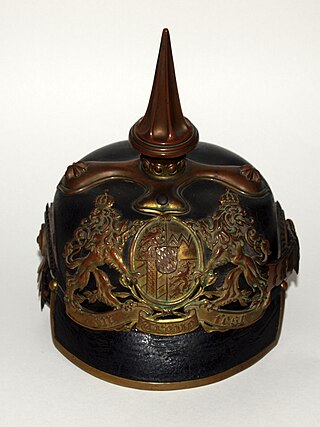
The Pickelhaube, also Pickelhelm, is a spiked leather or metal helmet that was worn in the 19th and 20th centuries by Prussian and German soldiers of all ranks, as well as firefighters and police. Although it is typically associated with the Prussian Army, which adopted it in 1842–43, the helmet was widely imitated by other armies during that period. It is still worn today as part of ceremonial wear in the militaries of certain countries, such as Sweden, Chile, and Colombia.

A helmet is a form of protective gear worn to protect the head. More specifically, a helmet complements the skull in protecting the human brain. Ceremonial or symbolic helmets without protective function are sometimes worn. Soldiers wear combat helmets, often made from Kevlar or other lightweight synthetic fibers.
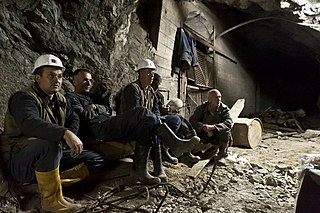
A miner is a person who extracts ore, coal, chalk, clay, or other minerals from the earth through mining. There are two senses in which the term is used. In its narrowest sense, a miner is someone who works at the rock face; cutting, blasting, or otherwise working and removing the rock. In a broader sense, a "miner" is anyone working within a mine, not just a worker at the rock face.

A hard hat is a type of helmet predominantly used in workplace environments such as industrial or construction sites to protect the head from injury due to falling objects, impact with other objects, debris, rain, and electric shock. Suspension bands inside the helmet spread the helmet's weight and the force of any impact over the top of the head. A suspension also provides space of approximately 30 mm between the helmet's shell and the wearer's head, so that if an object strikes the shell, the impact is less likely to be transmitted directly to the skull. Some helmet shells have a mid-line reinforcement ridge to improve impact resistance. The rock climbing helmet fulfills a very similar role in a different context and has a very similar design.

The Phrygian cap also known as Thracian cap and Liberty cap is a soft conical cap with the apex bent over, associated in antiquity with several peoples in Eastern Europe, Anatolia and Asia. The Phrygian cap was worn by Thracians, Dacians, Persians, Medes, Scythians, Trojans, Amazons and Phrygians after whom it's named. The oldest known depiction of the Phrygian cap is from Persepolis in Iran.

The Deutsche Volkspolizei, commonly known as the Volkspolizei or VoPo, was the national uniformed police force of the German Democratic Republic from 1945 to 1990. The Volkspolizei was a highly-centralized agency responsible for most civilian law enforcement in East Germany, maintaining 257,500 personnel at its peak. It worked closely along with the Stasi to maintain public order and identify threats to the regime.

The Stahlhelm is a term used to refer to a series of German steel combat helmet designs intended to protect the wearer from common battlefield hazards such as shrapnel.

Imperial Japanese Army uniforms tended to reflect the uniforms of those countries who were the principal advisors to the Imperial Japanese Army at the time.
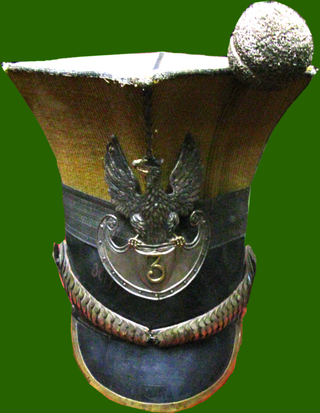
Czapka is a Polish, Belarusian, and Russian generic word for a cap. However, it is perhaps best known to English speakers as a word for the 19th-century Polish cavalry headgear, consisting of a high, four-pointed cap with regimental insignia on the front to which feathers or rosettes were sometimes added.
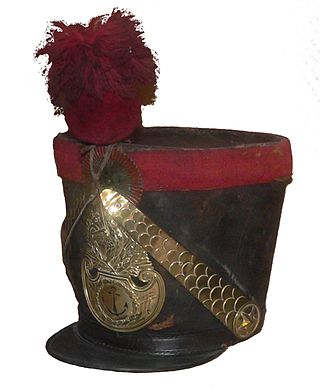
A shako is a tall, cylindrical military cap, usually with a visor, and sometimes tapered at the top. It is usually adorned with an ornamental plate or badge on the front, metallic or otherwise; and often has a feather, hackle, or pompom attached at the top.

The custodian helmet is a type of helmet worn predominantly by male police officers in the United Kingdom and within certain other places around the world. First used by the Metropolitan Police in London in 1863, the BBC labelled the custodian helmet a "symbol of British law enforcement". They are worn by male constables and sergeants on foot patrol. A cultural icon, it has featured in films, TV series and other media involving British police.

Schuberth GmbH is a German producer of safety helmets, combat helmets, protective headgear for Formula One, motorcyclists and industrial workers.

The pileus was a brimless felt cap worn in Ancient Greece, Etruria, Illyria, later also introduced in Ancient Rome. The pileus also appears on Apulian red-figure pottery.

The following is a general overview of the Heer main uniforms, used by the German Army prior to and during World War II.

Rupert Neudeck was a journalist who later in life expanded into humanitarian work, especially with refugees. He started as a correspondent for Deutschlandfunk, a German public broadcaster. Later, he focused on assisting those fleeing conflict, and assisted thousands of refugees from Vietnam in the late 1970s. Neudeck was a winner of numerous awards, including the Theodor Heuss Medal, the Bruno Kreisky Prize for Services to Human Rights, the Erich Kaestner Award and the Walter Dirks Award, and was co-founder of both the Cap Anamur and Green Helmets humanitarian organizations.

A miner's habit is the traditional dress of miners in Europe. The actual form varies depending on the region, the actual mining function, and whether it is used for work or for ceremonial occasions.

The Mooskappe is an old, traditional miners head covering. It was intended to protect miners when working underground from the impact of small rockfalls and from hitting their heads against the gallery roof (Firste). The term is German and this type of hat was worn especially in the Harz Mountains of Germany.

The lamellar helmet was a type of helmet used in Europe during the Early Middle Ages. Examples are characterized by caps made from overlapping lamellar scales, in addition to a brow plate, cheek guards, and camail. They are distinct from the contemporary spangenhelm and crested helmets also found in Europe; unlike those, which are influenced by Roman designs, Lamellenhelme display eastern influence and have primarily been found in southeastern Europe. They are mostly associated with the Avars of Pannonia and the Lombards of Italy.
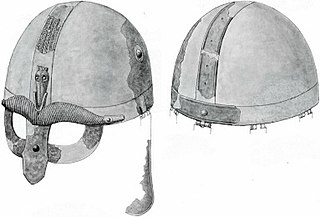
The Broe helmet is a decorated iron helmet from around the Vendel Period. Discovered around 1904 in a cremation grave in Broe, a farm on the Swedish island Gotland, it was located alongside other items including fragments of shields, weapons, bridles, and game pieces. Due to its extremely fragmented condition, only an incomplete reconstruction of the helmet is possible, but it appears to have been an example of the "crested helmets" that flourished in England and Scandinavia from the sixth through eleventh centuries.




















